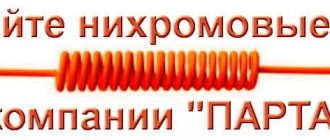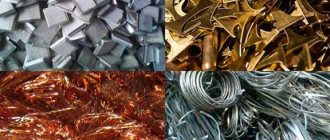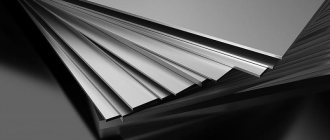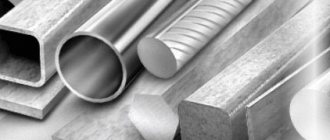Express methods for analyzing metals and alloys
Today, the most popular are two methods for determining the chemical composition of metals and alloys:
- X-ray fluorescence analysis (XRF, mainly in a portable version)
- Spark optical emission (atomic emission).
Both methods of metal analysis are characterized by high speed of chemical analysis and the ability to quickly determine the steel grade.
Analysis time is from 10 to 40 seconds.
Instruments for determining steel grade:
It has the greatest popularity among users. The most important advantage is that it is lightweight (about 2 kg) and can analyze metals even at low temperatures in the field. The portable metal analyzer operates both on batteries and on mains power. In addition, it does not require high quality sample preparation; There are no restrictions on the shape and weight of the sample.
Effectively determines steel grades and elements: Ti, V, Cr, Fe, Co, Ni, Cu, Nb, Mo, Zn, Se, Zr, Ag, Sn, Ta, W, Au, Hf, Pb, Bi.
However, due to weak fluorescence, it does not determine or has limitations in determining the concentrations of light elements: C, S, P, Si, Al, Mg, Na, Li, Be, B, N
Of the minuses, we can add that it measures concentrations only from 0.05%. We can talk about accuracy only at sufficiently high concentrations.
This method of analyzing metals and alloys is the most accurate. Detection limits for some elements reach 0.00001%. In addition, there is good agreement between the results of chemical analysis of metals for carbon, sulfur and phosphorus. It is possible to determine nitrogen and boron. Able to accurately determine grades of steel and cast iron.
These devices are available in tabletop or floor-mounted versions.
There are also portable spectrometers in this class of devices (with a remote sensor on a fiber optic cable). Their main disadvantages are significant weight and worse indicators in the analysis of C, S, P, N
Conclusions:
A portable XRF gun, type MIX 5, is suitable for carrying out sorting work in warehouses and approximate determination of steel grades.
For accurate input analysis of alloys for compliance with the certificate and in foundry production, the M5000 spark optical emission metal analyzer is suitable.
Factors on which the price of the device depends
It is difficult to say how much it will cost to purchase a spectrometer for the analysis of metal alloys. After all, the cost of such a device is influenced by a number of factors:
- Principle of operation.
- Quality (depends on the quality of manufacturing and assembly materials).
- Dimensions and weight.
- Accuracy (the higher it is, the more expensive the device will cost).
- The manufacturing company (the more famous it is, the better its reputation, the more expensive its product will cost).
- Easy to use.
- Place of purchase (instruments for analyzing metal alloys are sold cheaper on the Internet and on the market).
- Necessity of delivery (increases the cost of purchase).
- Seller's pricing policy (discounts, promotions make the purchase more profitable).
LIS-01, price - 1,428,000 rubles.
Chemical composition, chemical analysis of metal:
Determine the chemical composition of steels and alloys
Confirm steel grades
Restore product documentation
Confirm or deny a certificate
Incoming inspection of metals and alloys
Sorting scrap from ferrous and non-ferrous metals
Determine the chemical composition of ore rocks
Select analogues of steels and alloys (using a special program - steel grader Win Steel 8.0 Prof)
Ultrasonic thickness gauges 64 products
Types of thickness gauges
offers a wide range of thickness gauges of foreign and Russian production.
Thickness control is one of the mandatory technological stages in the production of metal structures, pipes, foil, polyethylene films, as well as in the application of coatings. To control thickness, thickness gauges are used - devices that measure thickness with one-sided access to the test object without violating its integrity.
There are three types of thickness gauges: magnetic, eddy current and ultrasonic. The main difference between these types is the physical principle on which the thickness gauge operates.
Ultrasonic thickness gauges
The operating principle of ultrasonic thickness gauges is to control the propagation of ultrasonic waves in the test object. Ultrasonic thickness gauges solve many problems and can control the thickness of both metal and coating in a short period of time (no more than 2-3 seconds). They are used to control the thickness of rubber, pipe walls, rolled metal and paint coatings. Advantages of ultrasonic thickness gauges: wide range of thickness control, high performance, low error, compactness and low price (compared to other types of thickness gauges). Because of these factors, many enterprises opt for ultrasonic thickness gauges.
Magnetic thickness gauges
The principle of operation of a magnetic thickness gauge is based on the Hall effect - when an object is placed in a magnetic field, a potential difference arises in it. Magnetic thickness gauges are used to measure the thickness of glass, plastic and aluminum containers, packaging materials, composite parts, automotive panels and non-magnetic coatings. These thickness gauges are divided into magnetic detachment gauges (for measuring the force of separation of a magnet from the test object) and induction gauges (for determining changes in magnetic resistance). Magnetic thickness gauges are characterized by a wide measurement range, high control performance and relatively low measurement error (2-3%).
Eddy current thickness gauges
The principle of operation is based on the excitation of eddy currents in the test object and subsequent recording of changes in the field of these currents, which are caused by changes in thickness. Eddy current thickness gauges are used to measure the thickness of dielectrics. They allow you to control the thickness of rubber products, plastics, glass and coatings applied to any metal substrate. The advantage of eddy current thickness gauges is their negligible impact on the accuracy and results of measuring the roughness of the product.
Ultrasonic thickness gauges for general use
Ultrasonic thickness gauges for general use are used in the inspection of pipelines, boilers, tanks, pressure vessels and other industrial facilities. These are portable devices that are easy to use and maintain.
Bulat. A series of instruments for measuring the thickness of metallic and non-metallic materials during their operation or after production. The Bulat-2 thickness gauge has the ability to measure the thickness of products under protective coatings (when using TMK converters). The range of measured thicknesses depends on the material and the transducers used. All devices in the series are portable and have a Rosstandart certificate.
TUZ-2 for monitoring the thickness of metal products, including products that are accessible only from one side. The TUZ-2 ultrasonic thickness gauge measures the wall thickness of pipelines, boilers, pressure vessels and other hazardous industrial facilities. It is possible to determine the degree of corrosive wear of a product by the residual thickness.
TEMP-UT1 has the ability to use any direct separate-combined converters without additional device settings. Operating temperature range: from -30 to +60°C.
A1207 . Compact ultrasonic thickness gauge with a 10 MHz transducer built into the electronic unit of the device. The device is suitable for express control. Operating temperature range from -30 to +55°C.
A1207C. Ultrasonic thickness gauge for assessing rail wear and measuring the actual thickness of metal parts and components of railway transport. The device is also used to control the wall thickness of plastic and metal pipes, vessels, boilers and casings with a roughness of up to Rz160. Radius of curvature: from 40 mm. Operating temperature range: from -30 to +60°C.
A1209. Ultrasonic thickness gauge for measuring the wall thickness of pipes, vessels, castings, ship hulls, rolled sheets, boilers and ferrous and non-ferrous metal products. A1209 has a unique system of automatic adaptation to the curvature and roughness of products. The device is used to measure the walls of narrow corroded pipes and flat products with a smooth surface. The thickness gauge is designed for the use of separate-combined converters with frequencies from 1.8 to 10 MHz. The basic package includes a 5 MHz converter.
DM5 series. Compact, lightweight models in a durable case and weighing 223g. The basic version includes a backlit LCD display and a set of functions: Min/Max coverage, alarm, B-scan, differential measurement mode. The DM5E thickness gauge has a DUAL MULTI measurement mode, which is used when measuring the thickness of metal products through a coating. The DM5E DL model has a built-in memory with a capacity of up to 50,000 measurements. It is possible to transfer files to a PC via the Mini USB communication port.
DMS-2. Digital thickness gauge with the ability to combine thickness measurements and observation of echo signal sequences. DMS-2 is used when measuring wall thickness on corroded products, at high temperatures and when working with layered materials.
PocketMIKE. A thickness gauge in which the electronic unit and converter are combined into a single device, like the A1207. The device has an automatic zero setting function. Protection degree IP67.
T-Mike Series. Performs one or two point calibration. The device is used for quick scanning with the ability to obtain data on the minimum thickness. Differential measurement mode. Memory for 40,000 measurements. Measurement mode “through a layer of paint”.
T-Scope III . Possibility of displaying the waveform. The A-Scan screen displays the amplitude and shape of the ultrasonic signal. The device takes measurements of heavily corroded objects (through the coating layer). Memory for 2000 measurement results.
UT-301 . Portable ultrasonic thickness gauge for testing the walls of pipes, vessels and boilers in the range from 0.5 mm to 300 mm, as well as for measuring the speed of ultrasonic vibrations. The device is used to control products with a small radius of curvature and with rough corroded surfaces. The transducer calibration can be stored. Range of change: from 0.5 mm to 300 mm.
TAKE OFF UT . Thickness gauge for measuring the thickness of objects in the gas, metallurgical, engineering and fuel industries. There is a mode for measuring the speed of propagation of longitudinal waves in products with high attenuation (with speeds up to 15000 m/s). The thickness gauge stores settings that remain viewable.
TAKE-OFF UT-M. Frost-resistant thickness gauge for measuring thickness in the metallurgical, gas, engineering and fuel industries at low temperatures. Range of measured thicknesses: from 1 mm to 300 mm (for steel). Ultrasound speed range: from 1000 m/s to 15000 m/s. Operating temperatures of the contact surface: from - 20 to + 80o C.
UT-93P . Thickness gauge for measuring the thickness of products made of structural metal alloys with one-sided access to them. The device has an alarm indicating the presence of acoustic contact of the controlled object with the transducer. Continuous operation time - up to 300 hours. Measuring range: 0.6 mm to 300 mm (accuracy +/- 0.1 mm).
A1210 Ultrasonic thickness gauge for measuring the wall thickness of steel pipes and metal products, cast iron, plastic, and other materials with high ultrasound attenuation. The device operates in two modes: in the mode of displaying measurement results in the form of digital values or in the mode of graphically displaying the A-Scan signal. The range of measured thicknesses (for steel) is from 0.7 to 300 mm. Continuous operation time 5 hours. Operating temperature range from - 20 to + 80°C.
38 DL plus for measuring wall thinning of corroded pipes. Sealed housing, dust and moisture protection level corresponds to IP67. Depending on the material and sensor, the thickness range is from 0.08 to 635 mm. The thickness gauge is suitable for testing surfaces heated to +500°C and has been tested for impact resistance.
45MG Ultrasonic thickness gauge for measuring the thickness of metals, plastics, composites, glass, ceramics and other materials. The device is also used for corrosion monitoring. Suitable for testing surfaces heated to +500o C. Depending on the material and sensor, the thickness range is from 0.08 to 635 mm. The degree of dust and moisture protection corresponds to IP67.
UT-111 . General purpose thickness gauge for manual contact measurement of the thickness of products made of metals and alloys, glass, ceramics, polymer and composite materials and ice. The thickness gauge is also used to control the residual thickness of products and metal structures located under water. The range of measured thicknesses (for steel) is from 0.6 to 500 mm. The degree of protection corresponds to IP65. Operating temperature range from - 10 to + 50o C.
UT-2 . General purpose thickness gauge for measuring the thickness of products made from structural metal alloys and non-metallic materials with single-sided access. Objects of measurement of the device: sheets, walls of vessels, boilers, pipes, pipelines, products for various purposes, including those with painted or corroded surfaces. The range of measured thicknesses (for steel) is from 0.8 to 200 mm. The continuous operation time of the device is 10 hours. Operating temperature range from - 20 to + 60o C.
DMS GO series for monitoring facilities in the oil and gas and energy industries. The series devices are used to control coated and uncoated materials. Protection degree IP67. Suitable for testing surfaces heated to +540o C.
BoltMike ultrasonic tension and clamping force meter for threaded connections in a shock-resistant plastic case. The range of controlled bolt lengths is from 19 to 6350 mm. Continuous operation time on AA batteries up to 40 hours.
Ultrasonic device Bondtracer for determining the airworthiness of an aircraft. This is a simplified device for personnel who do not have special training in non-destructive testing. Protection degree IP 54. Operating time on AA batteries up to 8 hours.
Precision thickness gauges
Precision thickness gauges are used to measure the thickness of stamped or blown plastic products, metal machined products or castings, glass bottle walls, flasks and rubber tubes, plastic cable sheaths, laminated fiberglass and composite products, and ceramic products. Accuracy depends on the condition of the material and surface preparation. On average it is ± 0.025 mm.
Thickness gauge 27MG for precision measurements of the thickness of corroded walls of metal pipes, with one-sided access to the test object. Compact and lightweight (0.34 kg), runs on AA battery for up to 2.5 hours. The body of the thickness gauge is shockproof and waterproof. Operating temperature range from -10 to +50o C.
Precision thickness gauge CL 5 for precision measurements of equipment wall thickness. Compact and lightweight (0.34 kg), the continuous operation time on a lithium battery is 25 hours. The built-in memory of the device stores up to 10 thousand measurement results. Resolution of measurements taken by the thickness gauge: up to 0.0001 mm. Operating temperature range from -10 to +60o C.
Precision thickness gauge CL 400 for manual contact measurement of the thickness of metal and alloy products. It is distinguished by high calibration accuracy with subsequent setting of tolerances for signaling. Thickness measurement range from 0.13 to 762 mm. Depending on the testing tasks, the thickness gauge is equipped with a set of ultrasonic transducers of various types (combined, separate-combined, interactive, etc.). The device has the option of automatically recognizing the type of converter and automatically setting zero in it.
Universal precision thickness gauge UDT-40 with A-scan. Eliminates doubling of readings and allows you to observe the profile of the bottom of the product. The thickness gauge has built-in matching circuits.
Corrosion thickness gauges
Corrosion thickness gauges are used to measure the residual wall thickness of metal pipes, tanks or cylinders that are subject to corrosion from the inside. The devices contain special methods for processing echo signals, providing measurements of the minimum residual thickness of the walls of test objects with uneven internal surfaces.
Thickness gauge A1208 with correlation processing of multiple echo signals. Can work with separate-combined and combined converters. A1208 allows you to measure steel thickness in the range from 0.8-300 mm without additional settings. Operating temperature range: from -30 to +50°C.
Lightweight thickness gauge Krautkramer DM4 (E, DL) for measuring the wall thickness of equipment, various structures and objects subject to corrosion. The DM4 allows for quick calibration with very easy operation. Automatic sound path correction ensures linear measurements over a wide range of thicknesses. Very useful for assessing pitting corrosion.
Ultrasonic multichannel thickness gauge A1250 Corroscan for wide-range corrosion control on metal objects with two-dimensional visualization of control results. The scope of application of the device is ultrasonic testing of high-pressure vessels with a wall thickness from 2 to 10 mm. Device weight 210 g. Operating temperature range: from -20 to +50°C.
Damask steel 1S (Aviation) for measuring the thickness of products and assemblies made of metallic and non-metallic materials and structures to determine their corrosion state. Measures steel thickness in the range from 0.5 to 200 mm. The device has an automatic gain control function. Device weight 230 g. Operating temperature range: from -20 to +50°C.
Damask steel 1S (for underwater work) for measuring the thickness of underwater and surface structures, products and assemblies made of metallic and non-metallic materials and structures to determine their corrosion state. Measures steel thickness in the range from 0.8 to 200 mm. The degree of dust and moisture protection of the device is IP41. Device weight 230 g. Operating temperature range: from -20 to +50°C.
UT907 for determining the residual wall thickness of pipes, tanks, etc. in order to identify places of corrosion and mechanical erosion of the metal. The range of measuring the thickness of steel products is from 0.5 to 500 mm. The device has a function for automatically adjusting the electro-acoustic path. Device weight 210 g. Operating temperature range: from -10 to +45°C.
Electromagnetic-acoustic thickness gauges
Electromagnetic-acoustic thickness gauges combine the operating principles of magnetic and ultrasonic devices. The peculiarity of such thickness gauges is that they measure during dry contact with the surface, without the use of contact liquid.
Electromagnetic-acoustic thickness gauge A1270 for testing products made of aluminum, aluminum alloys and steels without the use of contact liquids. A1270 allows you to work with a gap or through a coating, as well as evaluate the degree of anisotropy of rolled products. The thickness gauge communicates with a computer via a USB port and stores 19,800 measurement results.
Ultrasonic thickness gauge UT-04 EMA (Delta) for measuring the thickness of products made of conductive materials with one-sided access and assessing corrosion damage to inaccessible surfaces. The device measures thickness without the use of contact fluid or surface pretreatment. The range of measured thicknesses is from 1 to 200 mm. The thickness gauge takes measurements through the thickness of a non-conductive coating up to 2 mm. Operating temperature range: from -20 to +60°C.
Magna-Mike 8600 non-magnetic material thickness gauge for monitoring the thickness of plastic, glass and non-magnetic materials. The device operates based on the Hall effect. The range of measured thicknesses is from 0.001 to 25 mm. The degree of dust and moisture protection corresponds to IP67. Operating temperature range: from -10 to +50°C.
Sale and delivery of ultrasonic thickness gauges
Sales department consultants will help you choose a device suitable for your tasks and control objects.
We will deliver to all cities of Russia, as well as to the CIS countries and the Customs Union (Kazakhstan, Belarus, Ukraine, Tajikistan, the Republic of Moldova, Kyrgyzstan).
Consultations on the selection of an ultrasonic thickness gauge by phone +7 343 227-333-7 in Yekaterinburg and Moscow or by email, Monday to Friday from 9.00 to 18.00.
Found an error in the text? Select it and press Ctrl + Enter to help us fix it. Go back to the main page
ALL EQUIPMENT HAS VALID CERTIFICATES CERTIFICATES.
PMI MASTER UVR is a mobile optical emission metal analyzer that allows you to conduct high-precision analysis and determine the grade of any steels and alloys with the ability to analyze carbon, sulfur, and phosphorus.
ARC-MET-8000 is a portable optical emission analyzer operating in argon mode. With the ability to determine and excellent repeatability of results for carbon, sulfur, phosphorus and boron.
Stationary hardness tester according to the Rockwell method METOLAB101 The stationary hardness tester is used to measure the hardness of hard alloys, as well as hardened and non-hardened steels, castings, bearing steels, aluminum alloys, thin plates of hard alloys, copper, galvanized, chrome-plated and tin-plated surface coatings, etc. according to the method Rockwell. Certificate of type approval of measuring instruments RU.C.28.002.A No. 63563.
Measurement sequence
| X-MET 8000 is an X-ray fluorescence portable energy dispersive spectrometer with the ability to determine light elements Mg, Al, Si, P, S in accordance with GOST 28033-89. Range of measured elements: from Mg to Bi. |
Sample preparation according to GOST 7565-81
Measurement with a suitable analyzer
- X-MET 8000
- PMI MASTER UVR
| 1 | 2 | 3 | Processing results, issuing conclusions |
Why do we need spectral analysis of metals and alloys?
Conducting spectral analysis of metals using stationary or portable devices using the method of X-ray fluorescence spectral analysis of steel in accordance with GOST 28033–89 is intended to help specialized enterprises in sorting metal.
This solution demonstrates a number of advantages. It will not take much time to conduct a metal examination. The result will be known in a few minutes. Such a mini-laboratory for the chemical analysis of metal will significantly reduce the costs of a manufacturing enterprise, a large retailer and utilities. The price set for spectral analysis of metal in specialized organizations and their work schedule no longer matter: once you have purchased a metal analyzer and completed a training course for specialists who will work with it in the future, your company will be able to organize spectral analysis of metal at a convenient time and in a convenient place .
Chemical analysis of metal is used in the following cases:
Determination of the chemical composition of steels and alloys.
Restoration of product documentation.
Brand confirmation, certificate confirmation.
Incoming inspection of metals and alloys.
Sorting of scrap metals and alloys. Falsifications are quite common in this area, however, if the receivers use chemical analysis, metal determination, which gives the most accurate result, is guaranteed to save the enterprise from losses.
Selection of analogues of steels and alloys (using a special program - steel grader Win Steel 7.0 Prof).
Instrument calibration programs.
What substances does metal chemical analysis work with?
X-ray fluorescence analysis of the chemical composition of metals and alloys is carried out in the laboratory using an X-MET 7500 X-ray fluorescence analyzer with the ability to determine light elements Mg, Al, Si, P, S in accordance with GOST 28033-89. Range of measured elements: from Mg to Bi. The method is suitable for determining the chemical composition and grade of steel and other metals. In particular, it is allowed:
- chemical analysis of aluminum alloys;
- chemical analysis of titanium alloys;
- analysis of iron alloys, etc.
Read also: Which thermal heads for radiators are better
The universal program for the chemical analysis of alloys uses several fundamental parameters for the analysis of metals and alloys, a standard set of 33 elements: Mg, Al, Si, P, S, Ti, V, Cr, Mn, Fe, Co, Ni, Cu, Zn, As , Se, Y, Zr, Nb, Mo, Pd, Ag, In, Sn, Sb, Hf, Ta, W, Pt, Ir, Au, Pb, Bi in concentrations from 0 to 100%. Applicable for analysis of metals on any basis: Pb, W, Au, etc., ferroalloys
How to find out the composition of a metal - Metalist's Handbook
A labor-intensive problem at many scrap metal collection points is the process of separating incoming raw materials by grade and type of metal. Sometimes it is difficult to distinguish copper from alloys with a high copper content, and it is absolutely impossible to determine the nickel content in stainless steel. Therefore, when the incoming metal waste is heterogeneous, metal composition analyzers are used.
Two types of such devices have received practical application - those based on the use of the phenomenon of optical emission (laser) , and those using x-ray radiation .
Optical analyzers
Analyzers of metals and alloys of this type make it possible to determine with a high degree of accuracy the presence and content of light chemical elements - sulfur, phosphorus, carbon, i.e., those elements that are necessarily present in the chemical composition of any steel.
Optical metal analyzer - spark research method
Their action is based on the following: the fragment under study is exposed to a spark discharge in air. The resulting spark contains all of the above elements in ionized form, the emission of which is captured by the sensitive element of the device and displayed on the display.
The optical emission method makes it possible to quickly identify scrap metal without causing any noticeable destruction. Sometimes, in order to reduce the risk of explosion or fire, an inert gas, mainly argon, is used instead of air. Changing the research mode is carried out by simply reinstalling the nozzle.
— optical metal analyzer M5000 — description, characteristics:
The chemical composition of the metal is fixed in three ways:
- Branded, when the actual composition is compared with that indicated in the reference table. The method is relatively cumbersome because it requires human intervention;
- By imprint, when the emission spectra of the metal under study and the reference ones are compared;
- According to the “yes/no” principle, when it is necessary to answer the question of whether the sample under study is the metal or alloy that needs to be determined.
The scope of application of analyzers of the type considered is the study of low-carbon steels of the ferritic class, as well as stainless steels containing titanium, nickel, cobalt - elements whose emission spectrum is quite characteristic. Such devices are not widely used due to their increased sensitivity to the external conditions of the site where they are installed.
X-ray metal analyzers
Analyzers operating using X-ray radiation use the phenomenon of fluorescence, in which atoms of chemical elements emit photons of a strictly defined energy. A tube operating at a voltage of 45,000 V is used as a source of X-ray radiation.
In such conditions, it is necessary to allocate a special room for the analyzer to operate and equip it with a reliable lead protective screen.
Stationary devices operate in a similar way, which are used for the chemical analysis of large fragments of metal, but such analyzers are an anachronism; they can still be used in old laboratories left over from Soviet times, but are now becoming less and less common.
Now wearable, compact devices have become widespread - portable metal analyzers , intended for use directly at scrap metal collection points. They do not use radioisotopes and are therefore considered safer.
X-Ray Handheld Metal Analyzer - Can do chip analysis easily
With the X-ray method of determining the chemical composition of a metal, it is analyzed at 45 positions, which are determined by the different energy levels of the emitted electrons. Accordingly, a similar number of elements is determined, which is the main advantage of the method.
In addition, such analyzers are compact, easy to use, and constantly updated software allows you to improve the processing of the results obtained.
Description of the operation of a portable X-ray analyzer
X-ray analyzers of chemical composition consist of a fluorescent X-ray tube, a detector, a recording device and a control unit. The detectors are adapted for solid-state operation, and therefore are very convenient for use at large collection points for ferrous and non-ferrous scrap metals.
Portable Metal X-Ray Spectrometer
Technological capabilities of X-ray analyzers:
- The determination method is multicomponent (the percentage content of several chemical elements is simultaneously determined);
- Radioisotope sources – absent;
- The number of simultaneously determined parameters is up to 33 (regardless of the atomic mass of the element);
- The type of initial sample for analysis is any, including slag and dust fractions up to 50 microns (can be used to determine rare and rare earth elements in industrial waste, shavings, etc.);
- Visualization of research results - color display and registration in the base file of a special computer (it is also possible to connect to a regular computer via a USB connector).
Such characteristics allow the analyzers to be used in determining the type of metal, identifying the grade of non-ferrous alloy, technological control in the process of metal smelting, etc.
X-ray analyzers work quite quickly because they do not require preliminary setup of the device. Calibration will be performed only when solving special research problems.
Laser analyzers of the chemical composition of metals and alloys
in English - test of the Sciaps Laser-Z300 laser analyzer
These devices appeared relatively recently. They use the principle of deep scanning of a sample using quantum laser radiation. Since the laser radiation spectrum can be tuned much more finely than the X-ray spectrum, analyzers of this type have a number of operational advantages:
- The number of determined chemical elements increases significantly (up to 90, and therefore such installations are recommended to be used to determine the chemical composition of complex multicomponent alloys);
- The accuracy of recording a particular chemical element increases, which makes it possible to identify an alloy even with a percentage of the element less than 0.0005%;
- The device is suitable for the quantitative determination of the radioactive component, which is especially important for the radiation safety of equipment and workers. The possibility of receiving scrap that is “dirty” in radioactive terms is cut off;
- Laser-type devices consume significantly less energy, which allows them to be used for a long time without recharging the batteries;
- Since the laser scanning speed is very high, the process of determining the chemical composition of even a multicomponent alloy takes a fraction of a second.
Displaying laser analyzer results on the screen of an Android smartphone
The result of the laser analyzer can be displayed on the monitor screen, or can be recorded by the built-in video camera or displayed through a special application on the smartphone screen.
Average market prices for analyzers of metals and alloys
Spark optical emission spectrometers are perhaps the most expensive; the price of such analyzers can reach up to $50,000.
Portable X-ray metal analyzers cost a little less, but the price is also quite high - about $20,000 - $30,000.
Laser spectrometers are the latest generation analyzers, gaining more and more popularity; over time, the price will fall, now the cost is approximately $30,000-$40,000.
On the Internet, even sellers on their websites do not always have the same price. Those. There is a product, there is a description of the analyzer, a large selection of devices is presented, but in the price field it says “Make a request” or “Find out the price”. Where you leave your contact information and wait for a response with a price.
This can be explained this way - a metal analyzer is an expensive device, not every metal receiving facility can afford it. In order not to lose a client and bring the sale to completion, managers prefer to conduct a dialogue directly with the client, varying the price and other bonuses when purchasing an analyzer from them.
In other words, this is a marketing ploy that brings the seller and buyer closer together, which makes selling a metal analyzer easier.
— the most budget metal analyzer Delta Element
How to determine steel grade
There are simply a huge number of different steel options, each grade is characterized by its own specific features. If the manufacturer has not carried out markings, then you can find out the characteristics of the metal only by independently conducting various tests. We'll talk about this in more detail later.
How to determine steel grade
Methods for determining steel grade
A fairly common question is how to determine the grade of steel. There are several common methods:
- The first involves removing chips from the surface, for which a chisel can be used. At high carbon concentrations it will be short and brittle. A decrease in the indicator causes an increase in plasticity. However, it is not possible to accurately determine the brand using this method.
- The second method involves hardening the product, after which it is necessary to make cuts. If the material is simply sawed before and after hardening, then it contains a small amount of carbon. Due to the increase in carbon concentration after treatment, the surface becomes too hard.
- Determining the steel grade by spark is based on a visual inspection of the sparks that are formed when processing the surface with a grinding wheel. With an increase in the size of the sparks and their number, the hardness index increases, which depends directly on the carbon concentration. Such a test does not give an accurate result, since the main characteristics of the flying chips depend on the force of pressing and some other points. You can find tables that decipher the qualities of a material based on chips.
Instruments for spectral analysis
What is an X-ray fluorescence analyzer?
An X-ray fluorescence spectrometer is an analytical instrument that detects every chemical element present in the sample being tested.
This device also determines the total amount of chemical elements in the sample.
X-MET 7500
X-ray fluorescence analysis of the chemical composition of metals and alloys is carried out using an X-MET 7500 X-ray fluorescence analyzer with the ability to determine light elements Mg, Al, Si, P, S in accordance with GOST 28033-89. Range of measured elements: from Mg to Bi. The X-ray fluorescence method is based on the dependence of the intensity of the characteristic fluorescence lines of an element on its mass fraction in the sample.
This type of control is used in the following cases:
- Determination of the chemical composition of steels and alloys.
- Restoration of product documentation.
- Brand confirmation, certificate confirmation.
- Incoming inspection of metals and alloys.
- Sorting of scrap metals and alloys.
- Selection of analogues of steels and alloys (using a special program - steel grader Win Steel 7.0 Prof).
Types of devices
According to the principle of operation, spectrometers can be as follows:
- X-ray fluorescence . X-rays are directed at the sample. Fluorescent radiation is reflected from the analyzer and recorded by the detector.
- Infrared . The product under study is exposed to infrared radiation. They judge the composition and characteristics of the material by the transmission and reflection spectra. Infrared devices are easy to use and highly accurate.
- Mass spectrometers . The principle of their operation is based on measuring the ratio of the mass of an atom to its charge. The quantitative composition of the alloy is determined.
- Atomic absorption . They work on the principle of elemental quantitative analysis using atomic absorption spectra. Atomic pairs are created. Radiation passes through them. The atoms absorb it. This creates resonance lines corresponding to specific chemical elements. The devices are easy to use and highly selective.
Depending on the possibility of movement, the analyzer can be like this:
- Stationary.
- Portable.
Devices are distinguished by country of manufacture:
- Domestic.
- Imported.
Depending on the technical condition, the spectrometer can be:
- New.
- Used.
The following analyzers are available at the place of purchase:
- Taken from a private advertisement.
- Purchased from an online store.
- Ordered from an online trading company.
- Purchased on the market.
- Taken directly from the manufacturer.
VIHR-AM/T, price - 77,000 rubles.









